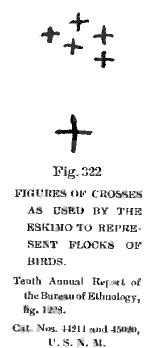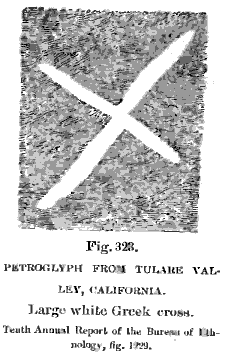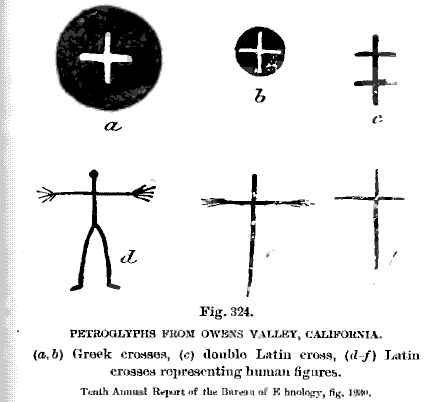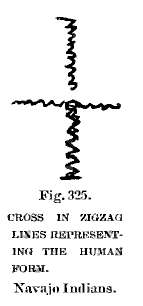

The Swastika
The Cross Among The American Indians
 form
the Najowe Valley group of colored pictographs, 40 miles west of Santa
Barbara, Santa Barbara County, Cal. The cross measured 20 inches in length,
the interior being painted black while the border is of dark red tint.
This design, as well as others in close connection, is painted on the
walls of a shallow cave or rock shelter in the limestone formation. Fourteen
miles west of Santa Barbara, on the summit of the Santa Ynez Mountains,
is a cavern having a large opening west and north, in which are crosses
of the Greek type, the interior portion being painted a dull earthy red,
while the outside line is a faded-black tint. The cross measures nearly
a foot in extent. At the Tulare Indian Agency, Cal. is an immense bowlder
of granite. It has been split, and one of the lower quarters has been
moved sufficiently to leave a passageway six feet wide and nearly ten
feet high. The interior walls are well covered with large painted figures,
while upon the ceilings are numerous forms of animals, birds, and insects.
Among this latter group is a white cross about 18 inches in length (fig.
323), presenting a unique appearance, for the reason that it is the only
petroglyph in that region to which the white coloring matter has been
applied.
form
the Najowe Valley group of colored pictographs, 40 miles west of Santa
Barbara, Santa Barbara County, Cal. The cross measured 20 inches in length,
the interior being painted black while the border is of dark red tint.
This design, as well as others in close connection, is painted on the
walls of a shallow cave or rock shelter in the limestone formation. Fourteen
miles west of Santa Barbara, on the summit of the Santa Ynez Mountains,
is a cavern having a large opening west and north, in which are crosses
of the Greek type, the interior portion being painted a dull earthy red,
while the outside line is a faded-black tint. The cross measures nearly
a foot in extent. At the Tulare Indian Agency, Cal. is an immense bowlder
of granite. It has been split, and one of the lower quarters has been
moved sufficiently to leave a passageway six feet wide and nearly ten
feet high. The interior walls are well covered with large painted figures,
while upon the ceilings are numerous forms of animals, birds, and insects.
Among this latter group is a white cross about 18 inches in length (fig.
323), presenting a unique appearance, for the reason that it is the only
petroglyph in that region to which the white coloring matter has been
applied. An
interesting example of rock sculpturing in groups is in Owens Valley,
south of Benton, Cal. Among them are various forms of crosses, and circles
containing crosses of simple and complex types. The most interesting in
this connection are the groups in fig. 324, a and b. The
larger one, a, occurs upon a large bowlder of tracite 16 miles
south of Beuton, at the "Chalk grave." The circle is a depression
about one inch in depth, the cross being in high relief. The small cross
b, found three miles north from this is almost identical, the arms
of the cross, however, extending to the rim of the circle. In this locality
occurs also the cross, c, same figure, and some examples having
more than two cross arms.
An
interesting example of rock sculpturing in groups is in Owens Valley,
south of Benton, Cal. Among them are various forms of crosses, and circles
containing crosses of simple and complex types. The most interesting in
this connection are the groups in fig. 324, a and b. The
larger one, a, occurs upon a large bowlder of tracite 16 miles
south of Beuton, at the "Chalk grave." The circle is a depression
about one inch in depth, the cross being in high relief. The small cross
b, found three miles north from this is almost identical, the arms
of the cross, however, extending to the rim of the circle. In this locality
occurs also the cross, c, same figure, and some examples having
more than two cross arms.Human forms. --- Other simple crosses represent the human form. Some of these are engraved or cut on the rocks of Owens Valley and are similar to those above described (fig. 324), but they have been eroded, so that beyond the mere cross they show slight relation to the human body (fig. 324, d, e, f). Col. James Stevenson, describing the Hasjelti ceremony of the Navajoes, (1) shows the form of a man drawn in the sand (fig. 325). Describing the character shown in fig. 326, Keam says: "The figure represents a woman. The breath is displayed in the interior." (2)

 Sometimes
the hair, instead of being worn in the complete discoidal form, is dressed
upon two curving twigs, and presents the form of two semicircles upon
each side of the head. The partition of these is sometimes horizontal,
sometimes vertical. The combination of these styles (fig.
327a and b) present the forms from which the Maltese
cross was conventionalized. (3)
Sometimes
the hair, instead of being worn in the complete discoidal form, is dressed
upon two curving twigs, and presents the form of two semicircles upon
each side of the head. The partition of these is sometimes horizontal,
sometimes vertical. The combination of these styles (fig.
327a and b) present the forms from which the Maltese
cross was conventionalized. (3)Shaman's spirit. --- Among the Kiatéxamut and Innuit tribes, a cross placed on the head, as in fig. 328, signified a shaman's evil spirit of demon. This is an imaginary being under the control of the shaman to execute his wishes. (4)
Divers significations. --- The figure of the cross among the North American Indians, says Colonel Mallery, (5) has many differing significations. It appears "as the tribal sign for Cheyenne" (p. 383); "as Dakota lodges" (p. 582); "as a symbol for trade or exchange" (p. 613; "as a conventional sign for prisoners" (p. 227); "for personal exploits while elsewhere it is used in simple enumeration: (p. 348). Although this device is used for a variety of meanings when it is employed ceremonially or in elaborate pictographs of the Indians both of North and South America, it represents the four winds. This view long ago was suggested as being the signification of many Mexican crosses. And it is
ENDNOTES:
1. Eighth Ann. Rep. Bureau of Ethnology, p. 283. [Back]
2. Tenth Ann. Rep. Bureau of Ethnology, 1888-89, fig. 1165. Back
3. Ibid., fig. 1232. Back
4. Ibid., fig. 1231. Back
5. Ibid., fig. 729. Back
<< Previous Page Next Page >>
© 2004-2007 Northvegr.
Most of the material on this site is in the public domain. However, many people have worked very hard to bring these texts to you so if you do use the work, we would appreciate it if you could give credit to both the Northvegr site and to the individuals who worked to bring you these texts. A small number of texts are copyrighted and cannot be used without the author's permission. Any text that is copyrighted will have a clear notation of such on the main index page for that text. Inquiries can be sent to info@northvegr.org. Northvegr™ and the Northvegr symbol are trademarks and service marks of the Northvegr Foundation.

|